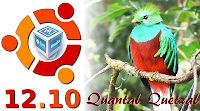 If you want to test Ubuntu 12.10 (Quantal Quetzal) without bothering yourself in partitioning your hard drive or dual booting with another OS, you can use VirtualBox which
allows to install multiple operating systems (Linux, Windows, Mac OS X,
etc.) in your host machine. This tutorial will explain to you how to
create a virtual machine and how to install Ubuntu 12.10 in it. These
steps are also applicable on other Ubuntu versions (12.04/11.10, etc.).
If you want to test Ubuntu 12.10 (Quantal Quetzal) without bothering yourself in partitioning your hard drive or dual booting with another OS, you can use VirtualBox which
allows to install multiple operating systems (Linux, Windows, Mac OS X,
etc.) in your host machine. This tutorial will explain to you how to
create a virtual machine and how to install Ubuntu 12.10 in it. These
steps are also applicable on other Ubuntu versions (12.04/11.10, etc.).If you are working on a host machine running Ubuntu, you can install the latest version of VirtualBox (version 4.2.0) with these commands:
echo
"deb http://download.virtualbox.org/virtualbox/debian
$(lsb_release -sc) contrib" | sudo tee
/etc/apt/sources.list.d/virtualbox.list
wget -q http://download.virtualbox.org/virtualbox/debian/oracle_vbox.asc -O- | sudo apt-key add -
sudo apt-get update
sudo apt-get install virtualbox-4.2
For other operating systems, you can download the appropriate file from here. Also, you need to download the iso image of Ubuntu 12.10 from here .
Creating The Ubuntu VM (Virtual Machine)
Open VirtualBox and click New, then in the VM setup wizard, click Next and enter a name for your VM (Ubuntu 12.10 for example):
Note: Once
you write "Ubuntu", the type of the OS will be
detected automatically.
In the next screen, keep "Start-up Disk" and "Create new hard disk" options selected, then click Next:
Select "VDI (VirtualBox Disk Image)" and click Next:
In this screen, you can choose any option, but it is recommended to select "Fixed size" because it will run faster with less errors:
Next, set the VM size, this depends on the free disk space you have on your physical hard drive (no less than 5GB):
Once your virtual machine is successfully created, right click it in the VM VirtualBox Manager and select "Settings":
Open the "Display" tab and check on "Enable 3D Acceleration," then click OK:
Installing Ubuntu 12.10 Quantal Quetzal
Start now the Ubuntu VM you have created. In the window for selecting an installation media, click the browse button and open the iso file of Ubuntu 12.10 you have downloaded from the link given above:
In the first installation screen, select "Install Ubuntu":
Select now an install language from given options and click Continue:
In the next screen, the options given are not necessary, but you can select them if you want to download updates from the internet and install some packages needed for running MP3, Flash, etc.
Since it is a new installation, we will select "Erase disk and install Ubuntu". Also, if you want to encrypt your hard disk, you can select "Encrypt the new Ubuntu installation for security", which is a new feature introduced in Ubuntu 12.10 allowing to encrypt the whole hard disk not only the home folder:
The installation will now begin, you can now proceed with the configuration of your user account by selecting firstly the city you live in:
Slect next the keyboard layout and click Continue:
Add now your user account details, then click Continue:
The installation will now proceed:
At the end of the installation, you will be required to restart your system:
That's it! Ubuntu 12.10 is now installed:



















No comments:
Post a Comment